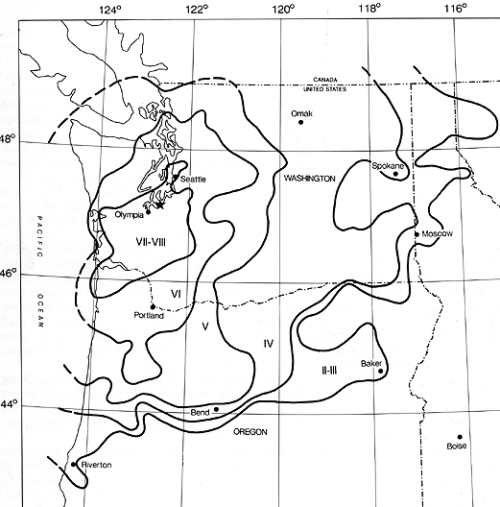When We Hear an A'yahos
Today, we hear an a'yahos. The University of Houston's College of Engineering presents this series about the machines that make our civilization run, and the people whose ingenuity created them.
April 13, 1949 -- downtown Portland, Oregon: I'm at the blackboard on the fourth floor of my junior college, working a problem in wave mechanics. Suddenly the building begins shaking violently. Across the street, window washers cling for dear life to their scaffold. I've just experienced a Richter 7.1 earthquake. It was centered up between Tacoma and Olympia -- right on the edge of the Seattle fault line.
Now science writer Kevin Krajick casts a new light on that quake as he tells about a creature described in the stories of the Duwamish natives of that region. They tell of an a'yahos -- a beast with features of both a serpent and a deer. It has heads on each end that look east and west. You must not look toward the a'yahos because the ground will shake and you'll turn to stone.
A'yahos legends are told in five places along the Seattle fault. In addition to smaller quakes, that area suffered a terrible shaking, eleven hundred years ago. (Perhaps I looked the wrong way when I was working at that blackboard.)
Krajick tells of a Klamath legend about a battle between the world around us and the underworld. It captures all the features of the eruption of Mt. Mazama and formation of Crater Lake. Pacific legends encode volcanic eruptions and solar eclipses.
Ancient Europe and the Middle East have plenty of stories. By now, we're pretty sure that both the Biblical flood and the flood of Gilgamesh describe the Mediterranean Sea breaking through the Bosporus Channel. That event, in 5500 BC, raised the Black Sea enough to flood 60,000 square miles of land. Other studies reveal that the Oracle at Delphi sat upon a fault that released ethylene, which messed with the Oracle's mind.
One after another, old stories are certified by science. You might even say that Adam and Eve have been narrowed down to a small number of African forebears who left their Eden in the Savannahs and moved eastward, across tip of the Red Sea into the Middle East. I still want to know the origins of the Daedalus story and, perhaps, one day I'll learn of the real event behind it.
All this leaves me pondering the thin line dividing history from legend. Perhaps the difference is to be found only in the language of the telling. I'm reminded of a story that Africans told the English explorer Richard Burton. They said that mosquitoes carried yellow fever. He laughed at natives who didn't understand that bad air simply arrived during mosquito season.
What we called superstition when natives told of it, achieved the status of scientific fact in the work of Walter Reed. But the facts had not changed one whit.
And yet the article warns us, let's not be too gullible in accepting every tale we're told as some reflecting some essential reality. Sometimes a tall tale is just a tall tale. Still, I do know that, on that morning so long ago in Portland, Oregon, I really was hearing the voice of the a'yahos.
I'm John Lienhard, at the University of Houston, where we're interested in the way inventive minds work.
K. Krajick, Tracking Myth to Geological Reality. Science, Vol. 310, No. 5749, 4 Nov. 2005, pp. 762-764.

USGS estimated isoseismal map for the April 13, 1949 Puget Sound earthquake. Portland, Oregon, was in the second hardest hit region.